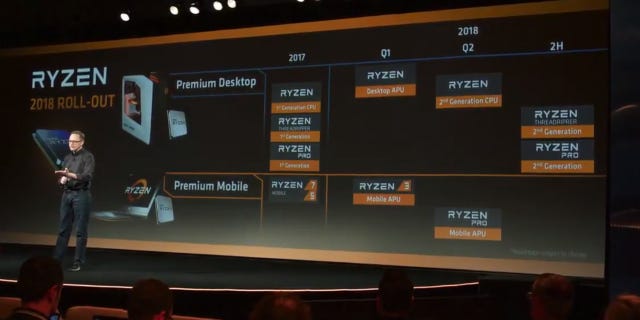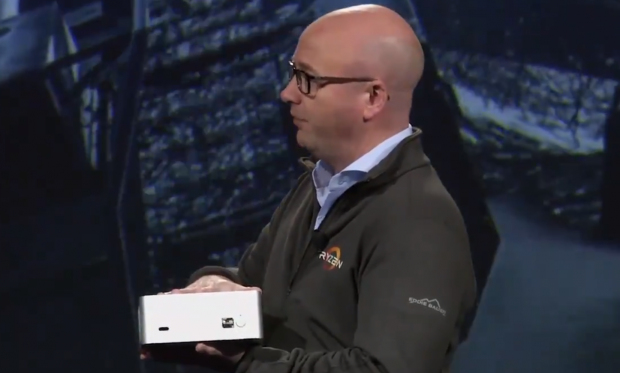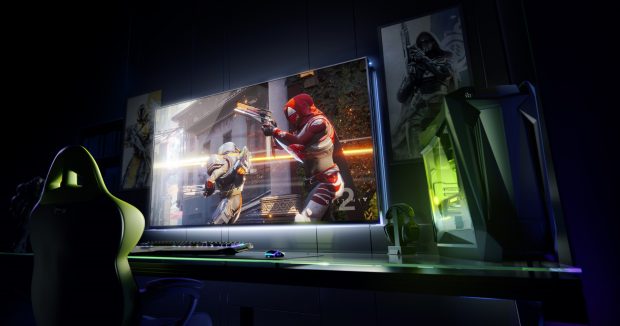CES 2018: AMD unveils new Ryzen CPUs and Nvidia takes gaming to the big screen
CPUs and big format displays dominate CES PC news
The yearly tech fest that is the Consumer Electronics Show (CES) doesn't officially start until tomorrow, but both AMD and Nvidia kicked things off early this weekend, detailing what's in store for the rest of the year regarding their latest graphics cards, CPUs, and... "big format gaming displays"? Read on for a potted summary of all the big important bits you might have missed.
Starting in the AMD camp, we finally saw the announcement of the first Ryzen desktop processor with built-in Vega graphics, a glimpse of Ryzen's second gen desktop CPUs that are due to launch this April, plus a full line-up of AMD's Ryzen Mobile chips that will be going into forthcoming laptops. Graphics news was a little light, all told, suggesting its new Navi-based cards are still a way off from an official unveiling, but AMD did say they will be introducing its first 7 nanometer (nm) Vega Mobile GPU for machine learning.
Going back to that first announcement for a moment, AMD said their new Ryzen-Vega processors - the quad-core 3.6GHz Ryzen 5 2400G and quad-core 3.5GHz Ryzen 3 2200G, to be precise - would have the highest performance graphics engine in a desktop CPU. That's a promising claim considering they'll cost just $169 and $99 respectively when they launch on February 12th.
Touting a score of around 5000 in 3DMark 11's performance benchmark for the Ryzen 2400G, this easily beats the 3100-odd figure produced Intel's integrated graphics on the Core i7-5775c in the same test, according to AMD, and should therefore theoretically provide a competent gaming experience at 1080p without the need for a discrete graphics card. Throw in FreeSync support and the fact they'll be able to fit into all AM4 motherboards, and the G-chips could suddenly become quite a potent combo for budget system builders and those after teeny tiny gaming PCs, such as the one below that was shown off during AMD's press conference.
Then, just two months later in April, AMD will release their second gen Ryzen chips, Ryzen+. While it doesn't look like these 2000-series CPUs will deliver a huge upgrade over the current gen chips, they should be more power-efficient thanks to their 12nm manufacturing process and onboard Precision Boost 2 support means they'll also be better equipped to regulate their turbo clock speed frequency under load. They won't require a complete system rebuild, either, as they'll run on current X300-series chipsets and slot into every AM4 motherboard.
That said, AMD said it will also be introducing a new X470 chipset that's supposed to be fully optimised for Ryzen+, with new boards using less power and providing better overclocking opportunities than their X300 counterparts.
As for AMD graphics news, most of it was about machine learning gubbins for cars that will mean little for PC gaming, so anyone hoping we might see Vega replacements for the RX 500 series will be sorely disappointed.
Still, at least it was a bit more exciting than what Nvidia had to show for itself, which was also largely about cars. Indeed, gaming only got a modest bit of stage time this year, but the two main announcements are thus: look forward to Nvidia's BFGD (or 'Big Format Gaming Displays') this year, and the fact that cloud service Nvidia GeForce Now, which was first announced for PCs and Macs at last year's CES, is now finally available as a free beta for most Windows users in Europe and North America.
Sticking with GeForce Now, well, er... now, this should (finally) be a huge boon for those looking to play games on their aging laptops without sinking thousands of pounds/dollars into a separate one for gaming. With it you'll be able to play all your games from Steam and UPlay via the cloud without the need for superpowered discrete graphics. Games can be streamed at up to 1080p resolutions and 120fps, and all driver and patch updates are installed automatically, with cloud saves enabled for cross-platform play.
Nvidia's BFGDs, on the other hand, will need to remain firmly at home. These giant 65in screens will be packed with all the latest tech, including 4K resolutions, a 120Hz refresh rate, HDR support, Nvidia's variable frame rate G-Sync tech and its very own Nvidia Shield streaming machine.
All displays, which are being made by Acer, Asus and HP at the moment, will have a peak brightness of 1000 nits (or cd/m2) and will also cover the full professional DCI-P3 colour gamut, so they should look pretty damn nice when they launch this summer. With an Nvidia Shield onboard as well, you'll also be able to stream your PC games to the display, play the latest Android games, and get built-in Netflix, Amazon Prime Video and all manner of other entertainment apps for when you decide you need a break from all that big-screen gaming.
No word yet on how much these things will actually cost, but when your typical 65in TV usually costs in the region of £1000-1500, I wouldn't be surprised if they end up being north of two grand when they finally hit stores. I'll keep you posted.










.jpg?width=291&height=164&fit=crop&quality=80&format=jpg&auto=webp)
